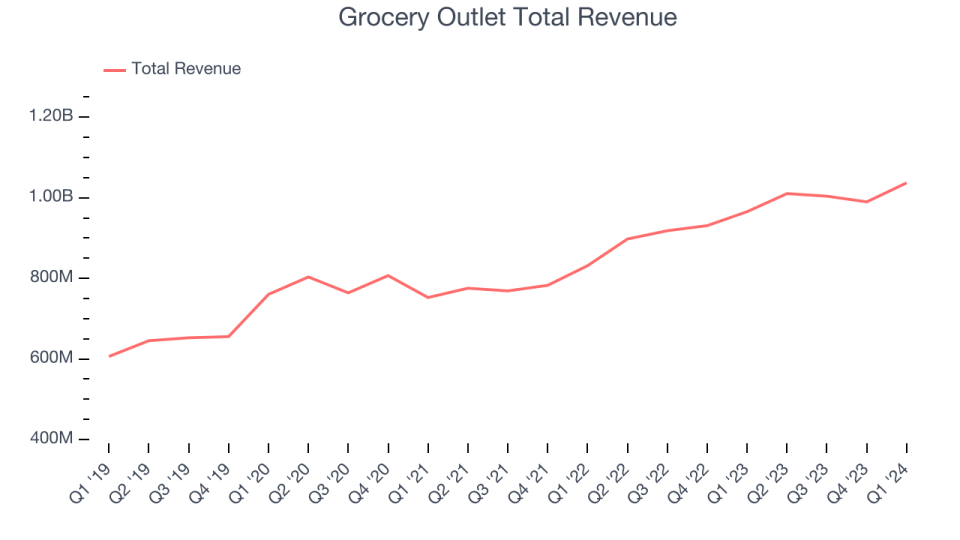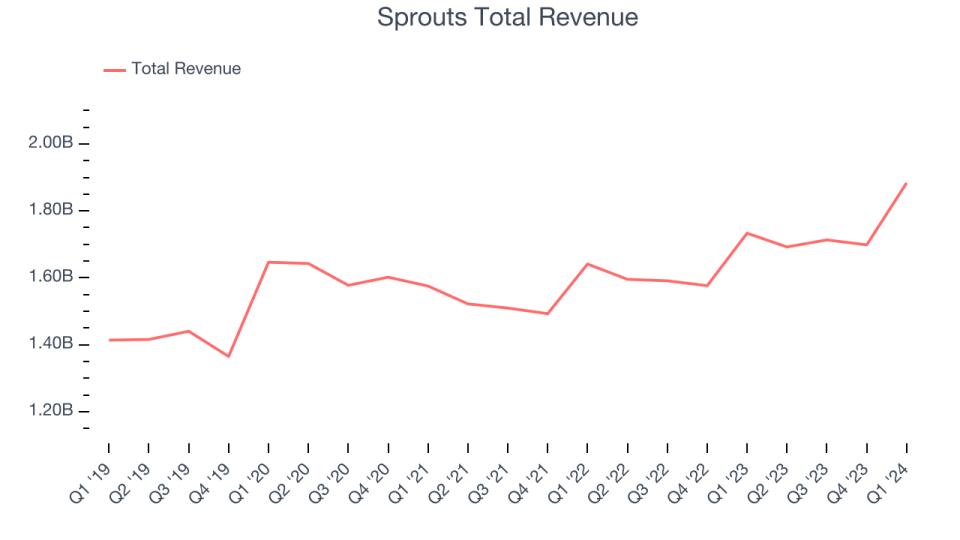Non-Discretionary Retail Stocks Q1 In Review: Grocery Outlet (NASDAQ:GO) Vs Peers

Let's dig into the relative performance of Grocery Outlet (NASDAQ:GO) and its peers as we unravel the now-completed Q1 non-discretionary retail earnings season.
Food is non-discretionary because it's essential for life (maybe not those Oreos?), so consumers naturally need a place to buy it. Selling food is a notoriously tough business, however, as the costs of procuring and transporting oftentimes perishable products and operating stores fit to sell those products can be high. Competition is also fierce because the alternatives are numerous. While online competition threatens all of retail, grocery is one of the least penetrated because of the nature of the product. Still, we could be one startup or innovation away from a paradigm shift.
The 6 non-discretionary retail stocks we track reported a decent Q1; on average, revenues beat analyst consensus estimates by 0.9%. Valuation multiples for many growth stocks have not yet reverted to their early 2021 highs, but the market was optimistic at the end of 2023 due to cooling inflation. The start of 2024 has been a different story as mixed signals have led to market volatility, but non-discretionary retail stocks have shown resilience, with share prices up 5.2% on average since the previous earnings results.
Weakest Q1: Grocery Outlet (NASDAQ:GO)
Due to its differentiated procurement and buying approach, Grocery Outlet (NASDAQ:GO) is a discount grocery store chain that offers substantial discounts on name-brand products.
Grocery Outlet reported revenues of $1.04 billion, up 7.4% year on year, topping analysts' expectations by 1.4%. It was a weak quarter for the company, with underwhelming earnings guidance for the full year.
"Our sales momentum remained strong during the first quarter as we continue to deliver unbeatable value with an exciting treasure hunt experience, driving continued growth in traffic and sales," said RJ Sheedy, President and CEO of Grocery Outlet.

The stock is down 13.7% since the results and currently trades at $22.38.
Read our full report on Grocery Outlet here, it's free.
Best Q1: Sprouts (NASDAQ:SFM)
Playing on the secular trend of healthier living, Sprouts Farmers Market (NASDAQ:SFM) is a grocery store chain emphasizing natural and organic products.
Sprouts reported revenues of $1.88 billion, up 8.7% year on year, outperforming analysts' expectations by 1.9%. It was a very strong quarter for the company, with optimistic earnings guidance for the next quarter and the full year.

Sprouts achieved the fastest revenue growth among its peers. The stock is up 29.2% since the results and currently trades at $83.01.
Is now the time to buy Sprouts? Access our full analysis of the earnings results here, it's free.
BJ's (NYSE:BJ)
Appealing to the budget-conscious individual shopping for a household, BJ’s Wholesale Club (NYSE:BJ) is a membership-only retail chain that sells groceries, appliances, electronics, and household items, often in bulk quantities.
BJ's reported revenues of $4.92 billion, up 4.1% year on year, in line with analysts' expectations. It was a slower quarter for the company, with a miss of analysts' gross margin estimates.
The stock is up 10.1% since the results and currently trades at $88.65.
Read our full analysis of BJ's results here.
Target (NYSE:TGT)
With a higher focus on style and aesthetics compared to other large general merchandise retailers, Target (NYSE:TGT) serves the suburban consumer who is looking for a wide range of products under one roof.
Target reported revenues of $24.53 billion, down 3.1% year on year, inline with analysts' expectations. It was a weaker quarter for the company, with underwhelming earnings guidance for the full year.
Target had the slowest revenue growth among its peers. The stock is down 6.8% since the results and currently trades at $145.2.
Read our full, actionable report on Target here, it's free.
Costco (NASDAQ:COST)
Designed to be a one-stop shop for the suburban consumer, Costco (NASDAQ:COST) is a membership-only retail chain that sells groceries, apparel, toys, and household items, often in bulk quantities.
Costco reported revenues of $58.44 billion, up 5.7% year on year, falling short of analysts' expectations by 1.2%. It was a mixed quarter for the company: Costco blew past analysts' gross margin and EPS expectations. On the other hand, its revenue unfortunately fell short.
Costco had the weakest performance against analyst estimates among its peers. The stock is up 3.2% since the results and currently trades at $810.5.
Read our full, actionable report on Costco here, it's free.
Join Paid Stock Investor Research
Help us make StockStory more helpful to investors like yourself. Join our paid user research session and receive a $50 Amazon gift card for your opinions. Sign up here.

 Yahoo Finance
Yahoo Finance 